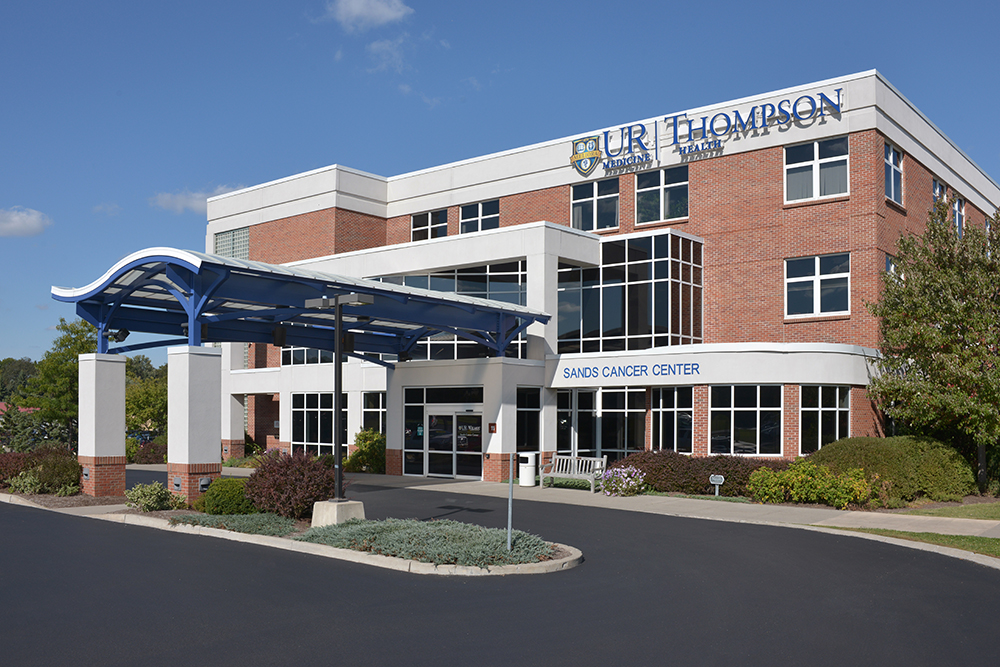CT simulators
- Megavoltage CT
- Cone-beam CT units
- Linear accelerators with IMRT and IGRT capabilities
- Ethos adaptive radiotherapy
- Brachytherapy
- Prostate seed implants
- GYN implants for gynecologic cancer
- Nucletron High Dose Rate Brachytherapy
- Liver radiation using Theraspheres
- I-131 treatment for thyroid cancer
- Radioactive mesh tumor bed boost for lung cancer
- Total Body Irradiation
- Accelerated partial breast radiotherapy using MammoSite or external beam
- Lutathera (lutetium Lu 177 dotatate) PRRT (Peptide Receptor Radionuclide Therapy) for patients with neuroendocrine tumors
Pluvicto (lutetium Lu 177 PSMA-617) treatment for patients with prostate cancer
Radiation Oncology
Make Appointments & Get Care
What is Radiation Oncology?
Radiation oncology is one of the three major cancer specialties in oncologic medicine. It uses energy from radiation beams, radio isotopes, or charged particles to target tumors and to eradicate cancer cells.
Radiation beams are usually generated in treatment machines, such as linear accelerators or high-energy CT scanners. Another type of radiation treatment uses radioisotopes, or radioactive materials. These are utilized in radiation implants and radioisotope-labeled molecules in the treatment of various cancers.
In addition to getting rid of cancer, radiation treatment is highly effective in reducing symptoms such as cancer-related pain. Radiation has also been used in the treatment of many benign (non-cancerous) conditions in both adults and children.
The Department of Radiation Oncology treats all types of cancer as well as some benign conditions. We treat the following types of cancer:
- Adrenal Metastasis
- Anal Cancer
- Benign Conditions
- Bile Duct Cancer
- Bladder Cancer
- Bone Metastasis
- Brain & Spinal Cancer
- Brain Metastasis
- Breast Cancer
- Cervical Cancer
- Colorectal Cancer
- Esophageal Cancer
- Gallbladder Cancer
- Head & Neck Cancer
- Liver Cancer
- Liver Metastasis
- Lung Cancer
- Lymphoma
- Lung Metastasis
- Mesothelioma
- Myeloma
- Ocular (Eye) Cancer
- Pancreatic Cancer
- Pediatric Cancers
- Prostate Cancer
- Recurrent Cancer
- Sarcoma
- Skin Cancer
- Stomach Cancer
- Thymoma
- Thyroid Cancer
- Uterine Cancer
- Vulvar Cancer
To learn more about the department, please visit our website.
Radiation OncologyUR Medicine's Approach
At the James P. Wilmot Cancer Center, the Department of Radiation Oncology is an essential part of multidisciplinary care. A team of experts from surgery, medical oncology, radiation oncology, and many other disciplines will come together to evaluate and manage your cancer treatment. This is a unique approach to care and is considered the ideal model of cancer care.
We provide state-of-the-art treatment technology to increase the curability of cancer while reducing side effects. Our comprehensive cancer care team includes physician radiation oncologists, radiation physicists, radiation therapists, dosimetrists, nurses, social workers, and nutritionists.
Some of the most common treatments offered are:
CT Simulator and Treatment Planning System with Image Fusion Capability
A CT simulation session is followed by a planning session when the customized radiation dose and physical design are made through high-end computer workstations by dosimetrists. During this process, other images (MRI, PET/CT, etc.) can be fused with our planning CT scans to precisely target the tumors and to avoid critical normal structures. When the final plan is approved by the radiation oncologists, it is transferred to the designated treatment machines for the delivery of radiation treatment.
Multidisciplinary Treatment
In many cases, the advanced radiation oncology treatments are provided in combination with surgery or chemotherapy. This is for brain tumors, lung cancer, gastrointestinal cancers, lymphomas, pediatric cancers, hepatobiliary cancers, breast cancer, head and neck tumors, prostate cancer, and other genitourinary cancers.
Respiratory Motion Management
We are constantly in motion – our breathing, hearts beating, and tummies rumbling all result in motion. We can monitor and even compensate for some of this motion using cutting-edge camera systems that track reflective markers that we place on your body, or optical or thermal image of your body surface during your initial CT simulation. You may be asked to hold your breath for short time intervals if you are able for some types of treatment, such as chest (e.g. for lymphomas), left breast, lung, or abdomen treatments. When you come back for your treatments, we will use those same reflective markers or body surface to make sure your breathing or breath-holding is the same as during your initial CT simulation.
Image-Guided Radiation Therapy (IGRT)
Precision radiation therapy requires that we know exactly how you are positioned every day. Image-guided radiation therapy allows us to visualize and align you to reproduce how you were positioned during your initial CT simulation so that we can be absolutely sure we are targeting the right area and sparing the nearby healthy tissues.
Ethos Adaptive Radiation Therapy (ART)
Intensity-Modulated Radiation Therapy and Image-Guided Radiation Therapy typically use a static image of what your body looked like during your initial simulation appointment to design your treatments and help position you for each treatment. However, our bodies change every day depending on what we ate or how much we drank, and the tumor may regress over the course of the radiation treatment. Adaptive radiation therapy allows us to customize how your radiation is delivered based on what your anatomy looks like every day during your treatment. Combining Image-Guided Radiation Therapy and high-powered computer automation, our institution is the only institution in all of upstate New York that can perform online adaptive radiation therapy to best target your cancer and spare the surrounding healthy tissue.
Stereotactic Radiosurgery (SRS)
A precise, single fraction of high-dose radiation is used to treat brain and spinal lesions. URMC has the greatest experience in the region in stereotactic radiosurgery and is considered a national leader in this technology. Employing state-of-the-art TrueBeam Edge machine with high-definition multileaf collimator and BrainLab ExacTrac Dynamic tracking system, a broad spectrum of conditions are treated at URMC using high-precision stereotactic radiosurgery from single benign or malignant lesion to multiple brain metastasis.
Stereotactic Body Radiation Therapy (SBRT)
High doses of radiation are delivered in a very precise fashion to a tumor in the body. This can help to eradicate certain types of tumors while protecting nearby normal tissue from damage. Treatments are completed over the course of about a week. This treatment is for primary tumors of the lung, liver, pancreas, prostate, or other organs or cancers that have metastasized to the brain, spine, lung, or liver. A number of cutting-edge respiratory motion management strategies are employed at URMC to mitigate tumor motion with breathing and ensure the accurate delivery of SBRT. URMC leads the upstate region in the employment of SBRT.
Brachytherapy
Brachytherapy is a type of internal radiation treatment. The doctor places a radioactive material, called source, inside of the body, either in cancer or close to it. Depending on the type of cancer, the source may be implanted temporarily or permanently. The low-dose-rate implant is a type of brachytherapy that often leaves sources inside the body. On the other hand, a high-dose-rate implant leaves the radioactive source inside the body for a brief period. The doctor takes out the source after treatment. Because the source is inside of cancer or close to it, brachytherapy can deliver very high dose radiation safely without exposing a large area of normal tissue, therefore it can be more effective at killing cancer cells but limiting the injury to the surrounding normal tissue. This treatment is for prostate cancer, gynecological cancers, breast cancer, and sometimes for sarcomas. URMC is nationally recognized for brachytherapy and is a national training site of the American Brachytherapy Society for prostate HDR brachytherapy.
Surface-Guided Radiation Therapy (SGRT)
Surface guided radiation therapy (SGRT) is a cutting-edge technology used to improve accuracy with radiation treatment. SGRT is used for treating nearly every cancer type, especially breast cancer, stereotactic radiosurgery, and thoracic and abdominal tumors. URMC utilizes state-of-the-art C-RAD Catalyst, BrainLab ExacTrac Dynamic, Varian Identify systems to deliver SGRT, such as treating left-sided breast cancer with deep-inspiration breath hold with SGRT to minimize heart toxicity.
Total Body Irradiation (TBI)
Total body irradiation (TBI) is a type of radiation therapy that is given to the entire body. It is often used in preparation for stem cell and bone marrow transplantation. TBI is used both for malignant conditions, such as leukemia, and benign conditions, such as aplastic anemia. TBI is planned in conjunction with chemotherapy prior to transplant. It is given either as a single treatment or in multiple sessions (up to eight treatments, twice a day) depending on the patient’s diagnosis and transplant treatment plan.
Theraspheres
A form of internal radiation, or brachytherapy, Theraspheres are used to treat primary liver cancer or other cancers that have metastasized to the liver. The Therasphere beads are injected into the tumor during a minimally invasive procedure. The radiation from the beads then works to kill the cancer cells while minimizing damage to the normal liver. This treatment is for liver cancer, bile duct cancer, and other cancer metastasis to the liver.
Lutathera/Peptide Receptor Radionucleotide Therapy (PRRT)
Lutathera, or Lutetium177 Dotatate, is a type of radiation medicine used to treat neuroendocrine or carcinoid tumors. The medicine consists of a radionuclide Lutetium 177 linked to a molecule called dotatate. The dotatate binds to receptors on the surface of neuroendocrine tumor cells. In this manner, the radioactive Lu177 enters the tumor cells and kills the tumor through internal radiation. The treatment is delivered via an intravenous (IV) injection.
Pluvicto
Pluvicto is a radiation-based medicine used to treat prostate cancer. It combines a radioactive substance called Lutetium 177 with a molecule called PSMA-617. PSMA-617 attaches to a marker called PSMA found on prostate cancer cells. Once it attaches, it delivers the Lutetium 177 into the cell, where it releases radiation to destroy the cancer cells. The treatment is given through an intravenous (IV) injection.
What Can I Expect from Radiation Oncology?
Your treatment will involve a team of healthcare providers from the Department of Radiation Oncology. Typically, a radiation oncologist will direct the radiation treatment process and plans. Your team will also include a secretary, a nurse, a nurse practitioner, a resident physician in training, radiation therapists who operate the treatment machines, and a radiation dosimetrist or physicist specializing in radiation treatment physical plans.
A typical radiation treatment process begins with an initial consultation with your radiation oncologist. The treatment recommendation, indication, rationale, benefits, side effects, and potential risks will be explained to you. This is followed by a radiation simulation session, which takes approximately one hour. This simulation process ensures the accuracy of your treatment plan.
Your actual treatment will begin 7-14 days later. However, patients with cancer-related emergencies can begin their treatments sooner. Daily treatment visits may take 15 -30 minutes and generally last 1 to 8 weeks, depending on the diagnosis and the treatment plan. The stereotactic brain radiosurgery is generally completed in one session. The stereotactic body radiosurgery is generally completed in less than 10 sessions.
Your radiation oncologist, therapists, and the team nurse will be there for you every step of the way. They will help you assess treatment-related side effects, your progress, and tolerance. The department offers assistance from social workers and nutritionists. Support groups for cancer patients are also available. These include disease-specific groups, age-specific groups, and many others.
Your cancer treatment team will be your very best resource for learning more about your disorder. A radiation oncologist will evaluate your treatment process during your treatment course at a one-on-one session with you at least once a week. The nurse, nurse practitioner, physician's assistant, and resident physician on your team will also be valuable resources regarding education about your disease or condition.
The Wilmot Cancer Center has a patient and family resource center for those seeking additional information about specific cancers as well as information concerning radiation therapy. The center is located on the 1st floor of the Cancer Center.
We offer state-of-the-art equipment for external beam radiation, including:
What Sets Us Apart?
The Department of Radiation Oncology at URMC is the region’s leader in radiation cancer treatment. We are also recognized nationally as one of the leading institutions in radiation technology, treatment and research in radiation and cancer biology, as well as radiation late effects.
The Department of Radiation Oncology treats all types of cancer as well as some benign conditions. More importantly, we provide treatment by subspecialists. In other words, the doctors who treat you have a large amount of experience in your specific type of cancer.
In many cases, your treatment will be confidentially discussed at our Disease Specific Tumor Board. In this conference, we call upon the expertise of over a dozen doctors—including oncologists, radiologists, and pathologists—to fine-tune your treatment. We also ensure that you will have access to the very latest technology and treatments. As a research institution, we often provide innovative treatments through NCI approved clinical trials that will not be available at other hospitals.
We are an American College of Radiology (ACR) accredited facility. ACR is a national professional organization serving more than 36,000 diagnostic/interventional radiologists, radiation oncologists, nuclear medicine physicians, and medical physicists with programs focusing on the practice of medical imaging and radiation oncology and the delivery of comprehensive health care services.
To achieve ACR accreditation, our facility’s personnel qualifications, equipment requirements quality assurance and quality control procedures have gone through a rigorous review process and have met specific qualifications. Every aspect of the ACR accreditation process is overseen by board-certified, expert radiation oncologists and medical physicists.
When you see the ACR seal, you can be assured that your treatment will be done at a facility that has met the highest level of quality and radiation safety. The facility and its personnel have gone through a comprehensive review to earn accreditation status by the ACR.
Locations
View All LocationsWe serve you in the Rochester metropolitan area and surrounding region.
View All Locations8 locations
Calkins Corporate Park (Red Creek)
125 Red Creek Drive
Rochester, NY 14623
Strong Memorial Hospital
90 Crittenden Boulevard
Rochester, NY 14642
262 Bank Street
Batavia, NY 14020
Noyes Memorial Hospital
111 Clara Barton Street
Dansville, NY 14437
Highland Hospital
1000 South Avenue
Rochester, NY 14620
Patient Education & Support
Related Services & Conditions
- Bone Cancer
- Brain & Spine Tumors
- Thyroid Cancer
- Pituitary Tumors (Benign)
- Gynecologic Cancer
- Bladder Cancer
- Breast Cancer
- Cervical Cancer
- Colorectal Cancer
- Endometrial Cancer
- Esophageal Cancer
- Head & Neck Cancers
- Gallbladder Cancer
- Kidney Cancer
- Leukemia
- Liver Cancer
- Lung Cancer
- Lymphoma
- Ovarian Cancer
- Pancreatic Cancer
- Penile Cancer
- Prostate Cancer
- Stomach Cancer
- Testicular Cancer
- Vulvar Cancer








